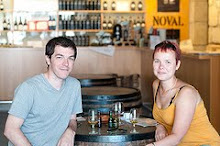Bright and early the following morning (ok ok, probably 9 am or so) we set out to walk around the city, meandering our way down to the water front – the perfect setting for a cup of coffee while huddling in comfy Finish wool blankets (take a look at the pics – they have the blankets out for people to use! In Chicago Kaivopuisto Park
Eventually we arrived at the Eteläranta docks and strolled the outdoor food and crafts market with all sorts of offerings (e.g., herring, garlic marinated in all kinds of good things, breads, salmon, other fish, meats, fruits and even pralines and chocolates). For lunch we visited the well known Sundman’s Krog for their Fish Buffet (€19 per person) which was quite good, with all sorts of herring (some marinated with dill and others with cardamom and sugar). The buffet seemed small; but trust us, we still managed to stuff ourselves! Afterwards we walked straight up the main road towards Hakaniemi Kauppahalli. Lee had read that this was a great place with boutique shops, but it was sort of a disappointment after the docks. Our tired feet directed us to home, even making us skip out on a blues show at a famous bar and restaurant.






The following day we explored the neighborhood of Kanavakatu, situated on a small peninsula on the east side of the city (Warning: Bit of a history and cultural lesson to follow – feel free to skip the next two paragraphs if you’re impatient!). The neighborhood is graced with enormous and beautiful art noveau style buildings built in the 1900-1910’s. Massive doors and fanciful balconies reminded us of Sevilla but with a Nordic twist.




We also checked out Seurasaari for the open airFinnish History Museum Finland Russia (controlled Finland from 1809- 1917) and Sweden (controlled Finland Finland served as a natural front between Sweden and Russia




We also checked out Seurasaari for the open air
Most Finnish houses were made from wooden logs, since forest land is abundant. In western Finland people lived in farmsteads (with courtyards in between buildings) and had a different yard for the people and stables for the horses, while keeping their other buildings and barns for the oxen, cows, chickens, pigs, sheep, and goats to the side (horses were cherished, hence why they shared the courtyard with them). The western Finnish made bread only twice a year so it had to last. Their “bread” is a hard, round, flat and thin disk that was stored with the grains. In general, western families were wealthier with larger houses, where the left side of their home (guest room, heater, and big meeting room) was solely for visitors (teachers, priests, etc.) and town meetings. School was held there and the priest or teacher would arrive and stay for three to four weeks to teach before moving on to the next village. A funny custom was that while servants and family members generally lived and slept together in the main living room, in wealthier families the oldest marriageable daughter had her own room so that she would be “kept pure.” In contrast, families from eastern Finland
On Sunday we took an hour bus ride to Porvoo, a small town with a historic center along the river. We walked the town and stopped by a second hand store to find Jazz a scarf and a sweater for a few dollars. We even got to enjoy some tasty Finnish pizza (thanks for the recommendation Lauren!). Lee’s slab of pizza included salami, smoked reindeer and olives, while Jazz’s included kebab meat, greek cheese, bell peppers, red onion, garlic and oregano (with bread sticks as “crust”). The town itself was so-so; lots of interesting buildings but also a fair number of tourists and kitsch shops.


Other notes on Helsinki – food is expensive (1.5 to 2 times US prices), bathroom floors are heated and for some reason there are a lot of old Chevy, Ford and US branded cars. Our impression of Helsinki (and therefore Finland Finland Russia
 Logging you in...
Logging you in...
